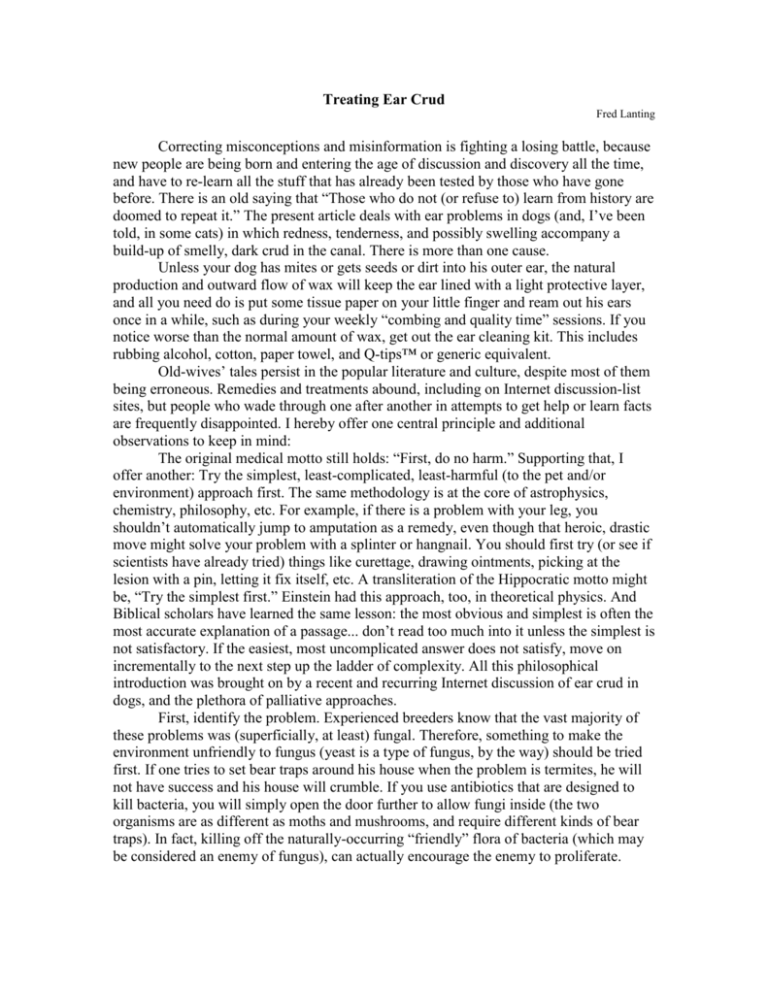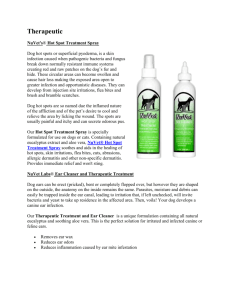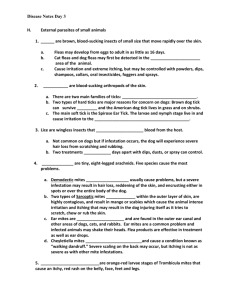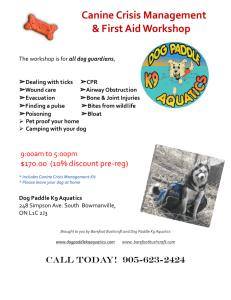Treating Ear Crud
advertisement

Treating Ear Crud Fred Lanting Correcting misconceptions and misinformation is fighting a losing battle, because new people are being born and entering the age of discussion and discovery all the time, and have to re-learn all the stuff that has already been tested by those who have gone before. There is an old saying that “Those who do not (or refuse to) learn from history are doomed to repeat it.” The present article deals with ear problems in dogs (and, I’ve been told, in some cats) in which redness, tenderness, and possibly swelling accompany a build-up of smelly, dark crud in the canal. There is more than one cause. Unless your dog has mites or gets seeds or dirt into his outer ear, the natural production and outward flow of wax will keep the ear lined with a light protective layer, and all you need do is put some tissue paper on your little finger and ream out his ears once in a while, such as during your weekly “combing and quality time” sessions. If you notice worse than the normal amount of wax, get out the ear cleaning kit. This includes rubbing alcohol, cotton, paper towel, and Q-tips™ or generic equivalent. Old-wives’ tales persist in the popular literature and culture, despite most of them being erroneous. Remedies and treatments abound, including on Internet discussion-list sites, but people who wade through one after another in attempts to get help or learn facts are frequently disappointed. I hereby offer one central principle and additional observations to keep in mind: The original medical motto still holds: “First, do no harm.” Supporting that, I offer another: Try the simplest, least-complicated, least-harmful (to the pet and/or environment) approach first. The same methodology is at the core of astrophysics, chemistry, philosophy, etc. For example, if there is a problem with your leg, you shouldn’t automatically jump to amputation as a remedy, even though that heroic, drastic move might solve your problem with a splinter or hangnail. You should first try (or see if scientists have already tried) things like curettage, drawing ointments, picking at the lesion with a pin, letting it fix itself, etc. A transliteration of the Hippocratic motto might be, “Try the simplest first.” Einstein had this approach, too, in theoretical physics. And Biblical scholars have learned the same lesson: the most obvious and simplest is often the most accurate explanation of a passage... don’t read too much into it unless the simplest is not satisfactory. If the easiest, most uncomplicated answer does not satisfy, move on incrementally to the next step up the ladder of complexity. All this philosophical introduction was brought on by a recent and recurring Internet discussion of ear crud in dogs, and the plethora of palliative approaches. First, identify the problem. Experienced breeders know that the vast majority of these problems was (superficially, at least) fungal. Therefore, something to make the environment unfriendly to fungus (yeast is a type of fungus, by the way) should be tried first. If one tries to set bear traps around his house when the problem is termites, he will not have success and his house will crumble. If you use antibiotics that are designed to kill bacteria, you will simply open the door further to allow fungi inside (the two organisms are as different as moths and mushrooms, and require different kinds of bear traps). In fact, killing off the naturally-occurring “friendly” flora of bacteria (which may be considered an enemy of fungus), can actually encourage the enemy to proliferate. Second, use the simplest effective ammunition. Stomping on a bug on your kitchen floor is probably better than attacking it with a shotgun or flame-thrower, though these would also kill it. If the dog’s dirty ears are more than a matter of having dug in a hole after rodents, you’ll have to go to the next more complicated approach—such as to use an anti-fungal drug. But you might not need to do so until you’ve given the simple cleaning approach a chance. If the ear canal is raw-looking (inflamed and/or cracked open), a little soothing ointment might be called for; this could be as simple as mineral oil or Vaseline™ (petroleum jelly) or a combination anti-bacterial/anti-fungal ointment (read the labels!) with a Vaseline base, but the sooner you can let the dog generate its own healthy ear wax, the better. Don’t use an anti-bacterial weapon (that’s what antibiotics are) unless the prime problem is clearly a bacterium. Now, as I mentioned, there are ointments whose various ingredients include some that attack bacteria, besides the ingredients that attack fungi, but ask yourself if you need them. Usually, if you soothe the integument (skin, ear leather’s inner surface, etc.) by getting rid of the fungus, the irritation in the cracked, raw skin that might be caused by bacteria as a secondary infection, is taken care of by the body’s natural defense system. If you don’t trust that or don’t have patience, you might want those combination salves. But understand that the presence or use of anti-bacterial ingredient(s) is less important than getting rid of the fungus. If you find an infection and/or infestation, you’ll want to have on hand the combination antibiotic/fungicide and perhaps (if you find evidence of mites) the miticide. For ear fungus, the acidic environment of plain, cheap white vinegar, on a daily or perhaps twice-weekly frequency, is usually sufficient. That should be preferable to making payments on your vet’s Lexus SUV. I have used a 50% water dilution in ears that are lightly bleeding or “raw,” but have had no bad reaction with full-strength vinegar after healing. Vinegar has a low (acidic) pH, and that’s what you need because the opportunistic fungus (which is always in the air) does not do well in acidic environments. Some people like to alternate vinegar with hydrogen peroxide cleanings. Use vinegardampened paper towels wrapped around your little finger. This will let you mechanically get the bulk of the crud out first; then a cotton swab-on-a-stick such as the abovementioned Q-tip. Twirl it in one direction only, on the way into the ear canal as well as on the way out, and clean out the channels all the way to the ear drum. If you pull off the dirty cotton and twist fresh cotton onto the stick, do so with that same directional motion, or it may come off in the ear. Note: many bottles of medicine or vitamins that used to have a plug of cotton to keep the pills from rattling around and breaking, now have a synthetic substitute such as polyester that might not be as absorbent as real cotton, but may get the job done anyway. If you waited too long to do the cleaning, and the ear is sore, you will have to persuade the dog that the pain is for his own good, and it will be better in a day or two as the open sores heal. But if you do your first one or two cleanings with Vaseline instead of vinegar, it will be easier on the dog and allow healing to start before you get a little more aggressive toward the organisms. Look at the illustration below. With the dog lying on his side, use the heel of your hand to keep his head down while pulling up on the “leather” (pinna, the longer part of the shell) with the thumb and first two fingers. In this manner, you can partly straighten out the sharp bend of the canal so you can get the vinegar-dampened swab all the way in. Despite warnings in the popular dog press and elsewhere about touching the eardrum, I have done this for over forty years with no problem. With a gentle touch, you can feel the swab bottom-out, and with a firm hand and soft voice you can keep the dog still while you clean the entire outer-ear canal, right down to the eardrum. Then go to the Q-tips again, dipped in a couple drops or so of the liquid, to clean out the crud from the crevices, wiping the stuff off the Q-tip until the cotton comes off and you have to use a new stick or put more cotton on it. Again, twist the swab in only one direction to keep it from falling apart. Use a clean cotton-tipped stick for the final cleaning each day you do it. See the pictures below. If it is indeed a bacterial problem, or you want to attack both bacteria and fungus at the same time, you might have success with a triple combination such as Enrofloxacin (or another anti-bacterial), Ketoconazole (for the fungus), and Triamcinolone (helps reduce inflammation). This “greasy” ointment’s viscosity may make it a little difficult to get it far into the ear canal, but if you use the cotton swab method, you should be able to clean out the crud and wax, and then coat the inner surface of the ear deeply. One that I use for a multitude of little bacterial problems is commonly labeled “triple-sulfa antibiotic” or a similar name, depending on what store I’m in when I buy a tube. Usually contains bacitracin zinc, neomycin sulfate, and perhaps polymyxin sulfate in a Vaselinetype base. I might alternate applications with a fungicide such as clotrimazole if I’m pretty sure a fungus is the problem, but only if the regular vinegar cleanings don’t satisfy. 99% of the time, cheap white vinegar from your pantry or laundry room (applied liberally with a paper towel or cotton swab, after cleaning out waxy build-up) does the trick. There are several such products, but do the home-remedy cleaning step first, as those preparations from your vet can cost around $2 or more per cc, and might not be needed. If it is, you can get it much more economically over the counter at any discount drug store. Vinegar is cheap and wonderfully effective against fungus. Third, you don’t drag out the bear traps or the shotgun unless you are sure you have a bear in your yard or kitchen. If it is more than a case of simply being dirty, you may have noticed a persistent return of crud, or a shaking of the head, or an unpleasant smell to the ears. Some dogs often lack natural and sufficient hormonal activity to prevent flea-bite allergy and other signs that the thyroid and other glands are not working optimally. It may be fighting merely a holding-action battle instead of winning the war, but there are things you can do to alleviate most of the discomfort. The skin, especially in certain areas such as belly, underarms, and pelvis/croup regions, may be affected. But it is the ear that usually is the most obvious place of irritation and symptoms. If the ear canal has an abnormal amount of wax, and if the accumulation is dark and smells unpleasant, it needs cleaning, but you should also attack the cause, not only the symptoms. I mean the immediate cause, as the underlying original cause may be that the immune system has been damaged such as from too-frequent and unnecessary 5-in-1type vaccines and inoculations, or a genetic weakness, or a combination of these two. You must clean the ears and keep them clean by repeated, frequent attention. Fourth (related to the first step of identifying the problem), consider that the problem may have arisen because of some weakness in the dog’s immune defense system. Very likely! We have found, in recent years, that too much childhood “medicine” and vaccinations are partially responsible for the dramatic increase in (human) asthma, autism, and other problems. We are starting to catch on to the fact that a few of us “dog people” have been preaching for so long, that over-vaccination (too often in some cases, too many given together in some, and unnecessary antigens in others) has deleterious effects on our pets’ health and longevity. The success of Kris Christine, Ron Schultz, and Jean Dodds in the vaccine battle is vibrant testimony to this. While most of the time it is a defensive action, the dietary use of immune-system boosters such as Vitamin E (and perhaps ellagic acid) can possibly help your dog cope with the burden of vaccinations, ear infections, and other problems that owners and veterinarians have caused. Geriatric or even much younger dogs whose immune systems have been damaged by age or overvaccination frequently have the same foul, rancid smell emanating from the entire external integument (the skin) that you may have earlier noticed only in the ears. Again, it is probably too late to cure or to erase the damage, but you might be able to control the smell by frequent bathing, a weak vinegar solution rinse, and immune-system dietary boosters. Do the cleaning every day until you can try every other day with success in controlling it. You might have to let the dog sleep outdoors or in a ventilated room of his own until you get a handle on this. Meanwhile, try to mitigate some of the damage to the immune system by giving vitamin-E supplements. However, the most effective control that I have found is one that is resisted by veterinarians: regular dosage or “supplementation” with thyroxine (one brand name is Soloxine). See my articles entitled Conception Problems and Soloxine, Immune System Problems in Canine, and Herpes as Neonatal Risk — Sub-Clinical Hypothyroidism (all found on http://siriusdog.com/article/author/Fred+Lanting). There is more info there. A final note with one small caveat: there is a very small chance that ear mites may be contributing to a few of the ear-crud problems. The deposits look different to the dog person with decades of wide experience, but not to many owners. If a miticide is called for, by all means, use it. If that’s the primary cause, I would consider a couple months of larger-dose ivermectin, and a miticidal shampoo as well. But this particular cause of crud is a small, infrequent actor on the stage. Enough that, until you get some miticide or schedule a possible vet visit if you can’t handle it yourself, you’d be wise to simply treat the symptoms. If you do find that the dog actually has a rare case of mites, they might be hiding in other parts of the coat, even to the tip of the tail—experienced breeders have long said that the same mites are usually found there, too. In fact, this may be one of the only excuses for frequent bathing until the critters have been killed or banished. Fred Lanting is an internationally respected show judge, approved by many registries for all breeds, and has judged numerous countries’ Sieger Shows, Landesgruppen events; he has many years experience as one of only two SV breed judges in the U.S. He conducts annual non-profit sightseeing tours of Europe, centered on the Sieger Show (biggest breed show in the world) and the BSP. He has also judged many National Specialties in numerous breeds. Known as the world’s leading non-veterinarian authority on hip dysplasia, he presents seminars and consults worldwide on such topics as Gait-&-Structure, HD & Other Orthopedic Disorders, and the German Shepherd Dog. A dog breeder since 1945, a GSD owner since 1947, and a show judge since 1979, he has lectured at numerous veterinary schools in the USA and abroad. He is the author of “must read” books for the dog owner (see below for ordering info). Curriculum Vitae available upon request. All Things Canine consulting division, Willow Wood Services Phone: 256-498-3319 Mr.GSD[at]netscape.com Also use this address for inquiries regarding judging or lecturing schedule and availability. Canine HD and Other Orthopedic Disorders Covers all joints plus many bone disorders; includes genetics, diagnostic methods, treatment options, and the role of environment. This highly-acclaimed book is a comprehensive (nearly 600 pages!), amply illustrated, annotated, monumental work that is suitable as a coffee-table book, reference work for breeders and vets, as well as a study adjunct for veterinary students, for the dog trainer and the general dog owner of any breed. The Total German Shepherd Dog This is the expanded and enlarged second edition, a “must” for every true GSD lover. It is an excellent alternative to the “genetic history” by Willis, but less technical and therefore suitable for the novice, yet very detailed to be indispensable for the reputable GSD breeder. Chapters include: History & Origins, Bloodlines, Anatomy, Movement, Shows, Training, Nutrition & Feeding, General Care, Health & First Aid, Parasites, Immunity, Diseases & Disorders, The Geriatric Dog, Breeding, Genetics, Reproduction, Whelping, The First Twelve Weeks, and a Trouble-shooting Guide. Conflict – a “War and Peace”-size novel of love, war, joy, suffering, and the meaning of life. Ask about it. Click here to purchase books by Fred Lanting More articles on: http://siriusdog.com/article/author/Fred+Lanting









